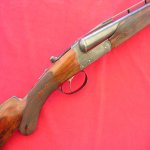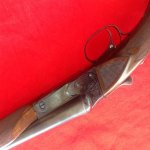You are using an out of date browser. It may not display this or other websites correctly.
You should upgrade or use an alternative browser.
You should upgrade or use an alternative browser.
LET'S SEE YOUR WINCHESTER MODEL 21's
- Thread starter Cow Town Bill
- Start date
This M21 is an early 50's 12 gauge, 30" solid rib 30" barrels choked mod and full. It has factory #5 engraving complete with factory letter. Handles really good on clays and even better on South Dakota pheasants.
Factory engraving with factory letter. Beautiful M21.
This is a Westley Richards that has a Win M21 look about it. It was made in 1915 and re-done by WR in 1986. The renovation included 30" vent rib barrels choked full and full. It was also restocked and a Miller single trigger added. This gun has outstanding shooting qualities. A number of experienced shooters have shot it and all agree it has magic qualities---just like rifles, some shoot better than others. A good friend convinced me that he needed it more than me. Such is collecting.


Attachments
Bill, I just got here and was going to comment (before I’d read your last post). Fabulous looking gun and re-do.
We have similar tastes in guns and related items.
Falconflyer
CGN Ultra frequent flyer
I haven't had much time for the forum lately Bill but that sure is a lovely WR, as are all the guns you've shown us. Your pictures are much appreciated!
browninggold
CGN Regular
- Location
- Essex County, Ontario
the WR was stunning! I just keep waiting for the next gun you post, you've had outstanding shotguns pass through your hands...must be quite a joy to own such fine pieces.
One trick is to not own them all at the same time.
Win M23's are very good guns but just don't have the feel nor nostalia of the "real deal".
I owned a Model 23. Serial # 00009. Kind of sort of a Mr. Lockham deal that involved a Model 21. One of those I describe in an above post.
The stock was very thin in wood on the sides of the Model 23 action. The stock split while shooting ducks. I went to Hagar the gunsmith, Mister Boyce had retired on the Island.
Hagar realized I had a bit of a problem. Out came the Dremel drill press and and some very small wood implants. Then came the fiberglass or whatever epoxy. Hagar should have went to dental school the way he operated on that stock.
Anyways, that gun was sold to a physician in Calgary. I am sure that stock will last whatever he puts through that barrel.
The lesson of this story is that a side by side is not meant to shoot cartridges that are made for a Benelli semi auto goose gun. Arietta 10 gauge side by sides being the exception.
I'm disappointed that no one has commented on the beautiful Westley Richards.
I didn’t want to start something. It is a lot nicer looking gun than an M21.
I didn’t want to start something. It is a lot nicer looking gun than an M21.
All depends upon an individuals preferences. Much like comparing apples to oranges. You are right the WR is an exceptional gun but there are M21's that have lots of appeal. Of course, you can be like me and enjoy both.
I didn’t want to start something. It is a lot nicer looking gun than an M21.
Oh this made me smile. I can appreciate the M21s here but they don’t stir my blood.
It reminds me of cars. I came of age (for cars) in the early 1970s. It seemed back then that if you liked sports cars, you fell into one of two groups. You either like English and Italian cars or you liked German cars. I was (and still am) decidedly in the English and Italian camp when it comes to automobiles. A little beauty and soul never hurts.
Oh this made me smile. I can appreciate the M21s here but they don’t stir my blood.
It reminds me of cars. I came of age (for cars) in the early 1970s. It seemed back then that if you liked sports cars, you fell into one of two groups. You either like English and Italian cars or you liked German cars. I was (and still am) decidedly in the English and Italian camp when it comes to automobiles. A little beauty and soul never hurts.
One should also look at the cultural aspects of a side by side.
What was and is a particular side by side built and designed for? And what shooting method are you going to use?
Where does one shoot driven game using the Churchill method of lead in Canada these days? A dirty little secret in Alberta and Saskatchewan is to use pigeon roosts around granaries to practice the Churchill method with that little gun safe princess you never talk about.
It is obvious that the model 21 initially was a working man's gun. It was a gun for the growing middle class. It provided a bit of prestige to the man who could afford one, and was a proven game getter. When you look at the box lock action of a model 21 those big coil springs are only seen in high level competition over and unders and amazingly in the Baikal side by sides.
Without going further, each side by side shotgun model has a story to it, and was made for a particular purpose.
And therein is the fun of reading about and shooting the gun.
Well, I kinda like the big coil springs in my Manufrance Ideal, designed over 40 years before the M21 was a gleam in John Olin’s eye. Manufrance encased those springs is as strong an action design as has been made. The only thing the M21 has on it is the increased leverage provided by the elongated action flats. IMHO. And it’s all wrapped up in a svelte round action.
But you are right, bluelynx, when you say each SxS was made for a purpose. The result is an incredible array of guns that can appeal to every taste, shooting style and quarry. I think, and I’m sure I’m not alone in this, that a big part of the fun is in discovering that variety. And can you imagine the prices if we all loved the same things?
But you are right, bluelynx, when you say each SxS was made for a purpose. The result is an incredible array of guns that can appeal to every taste, shooting style and quarry. I think, and I’m sure I’m not alone in this, that a big part of the fun is in discovering that variety. And can you imagine the prices if we all loved the same things?
Here is an interesting read regarding the side by side of choice for shooting sporting clays. The Win M21 is favoured by many shooters. So is the Perazzi DC12. Interestingly, there is no mention of English guns.
Side by Side opinions. Sorry the link didn't work but the discussion is in Trap Shooters Forum.
Side by Side opinions. Sorry the link didn't work but the discussion is in Trap Shooters Forum.
Last edited:
By far the majority of British side by sides are comparatively light field guns, commonly between 6 1/2 and 6 3/4 pounds. Guns intended for serious target work such as Sporting Clays usually weigh 7 1/2 to 8 1/2 pounds, sometimes more and are more comfortable to shoot over a full course of fire where the British lightweights can get punishing after one or two hundred rounds unless you are accustomed to this. The British have also made some (a few) heavier guns proofed at 1 3/8 or 1 1/2 ounce and they make a superb sporting clays gun if you can find a nice one. Bottom line - competitors want to win and will use whatever they think will help them achieve this goal.
Falconflyer
CGN Ultra frequent flyer
I like shooting my side by sides at sporting clays but only for 50 to 100 targets at a time, any more than that I'm using my 9 lb over and under for comfort!
By far the majority of British side by sides are comparatively light field guns, commonly between 6 1/2 and 6 3/4 pounds. Guns intended for serious target work such as Sporting Clays usually weigh 7 1/2 to 8 1/2 pounds, sometimes more and are more comfortable to shoot over a full course of fire where the British lightweights can get punishing after one or two hundred rounds unless you are accustomed to this. The British have also made some (a few) heavier guns proofed at 1 3/8 or 1 1/2 ounce and they make a superb sporting clays gun if you can find a nice one. Bottom line - competitors want to win and will use whatever they think will help them achieve this goal.
Couldn't agree more, Ashcroft.
I have heard that hunters/shooters in English driven bird shoots are going for heavier guns to reduce recoil. In particular the shooters/hunters are demanding higher birds which leads to heavier loads and increased recoil. I have read that David McKay Brown is making his round actioned guns with longer barrels and increased weight; and this is particularly true with his round actioned over unders. So, is the English game gun going through a transformation? Will Beretta be directing Holland and Holland in this direction? Will be interesting to see.
Yet another thought: David McKay Brown has announced his retirement and has taken his last gun orders. Will an interested party take over his successful operation? I hope so.
I like shooting my side by sides at sporting clays but only for 50 to 100 targets at a time, any more than that I'm using my 9 lb over and under for comfort!
I do the same and use light loads with my English guns.








































































